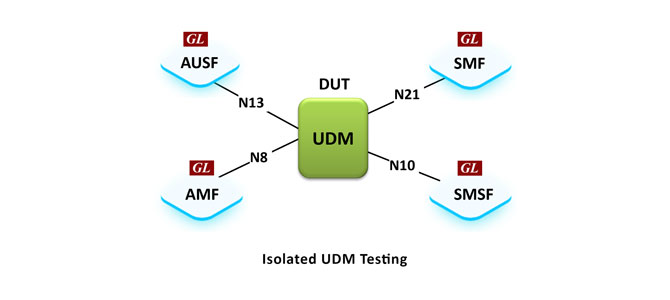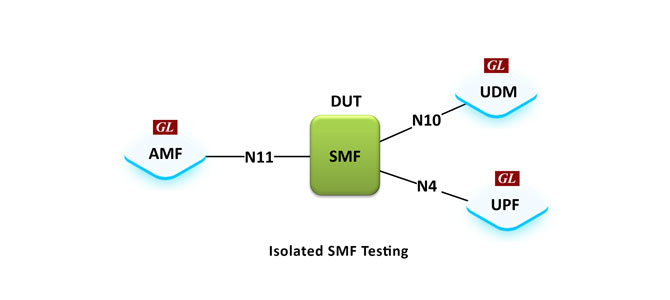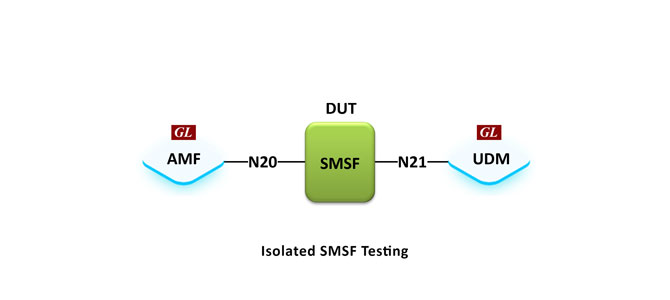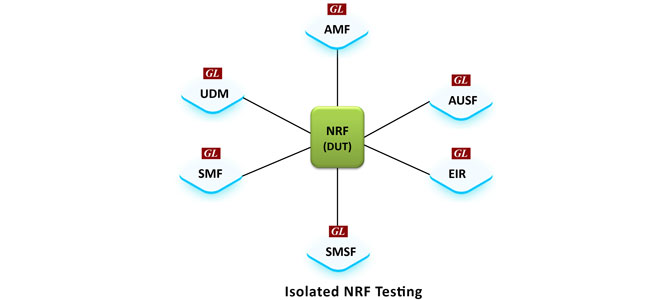5G Core Network and gNodeB (gNB) Emulation Test Solution
Emulate multiple UEs and 5G network elements such as UE, gNB (CU/DU), AMF, SMF, UPF, AUSF, UDM, EIR, and SMSF on the 5G Core network.
REQUEST A DEMO / QUOTE Brochure5G Core Network Emulation
Signaling and Traffic Emulation over 5G
The MAPS™ 5GC Network Emulator can emulate thousands of UEs and gNBs, along with multiple 5G Core Network elements such as gNB DU, gNB CU, AMF, SMF, UPF, AUSF, UDM, SMSF, and EIR. The Emulator is designed to test 5G base stations (gNBs) and 5G Core Network Functions (NF) according to 3GPP standards. With the help of mobile phones, and other emulated wireless networks, the 5G Lab setup can be operated in real-time for making VoNR calls and for interworking with 4G, 3G, 2G , PSTN and VoIP networks. The solution is equipped with ready-to-use scripts that emulate the full state machine behaviour of Network Elements, designed to conform to 3GPP specifications. These test scripts address general messaging and call flow scenarios for Network Elements, including multimedia call session setup and control over IP networks.
GL’s End-to-End Wireless Network Emulation Test Suite provides you an advanced full-fledged “Live Network” at your company premises in any customized package to suit test requirements. The test suite provides reliable integrated solutions to vendors and service providers for emulation, monitoring, troubleshooting any wireless network, including, 5G, 4G, 3G, and 2G. All functionalities conform to industry standards.
GL’s MAPS™ offers comprehensive support for emulating critical 5G Core (5GC) network interfaces, including N1N2, F1 and E1 (3GPP ORAN), and N4. It also supports a wide range of control-plane interfaces such as N8, N10, N11, N12, N13, N17, N20, N21, N22, N29, and N51. Additionally, it enables GTP-based user-plane traffic emulation over N3 and N6 interfaces.
Key Features
- Comprehensive 5G Network Emulation – Emulate the complete 5G Core and Access Network, including UE, gNB, gNB DU, gNB CU, AMF, SMF, UPF, AUSF, UDM, SMSF, and EIR
- Scalable Connectivity – Capable of connecting up to 500 real smartphones and thousands of virtual UEs, ideal for large-scale testing environments
- Web-Based Multi-User Access – Intuitive browser-based interface with support for remote access, multi-user collaboration, and distributed test management
- Realistic 5G Traffic Generation – Enables generation and verification of various traffic types such as VoNR, Email, FTP, Web (HTTP), Video, and more (requires ETH101/ETH102 licenses)
- Flexible Network Integration – Seamlessly interoperates with other wired and wireless networks for diverse and complex test scenarios
- Robust Validation Capabilities – Performs thorough testing of authentication processes, security mechanisms, and mobility procedures
- Advanced Resource Handling – Supports dynamic bandwidth allocation and temporary IP addressing for real-world simulation accuracy
- Versatile Testing Support – Ideal for a wide range of test types including Feature, Functional, Performance, Interoperability, and Migration testing
Supported procedures include both roaming and non-roaming, including interworking between 5GS (NG RAN +5GC) and EPS (4G RAN+EPC), mobility within 5GS, QoS, policy control and charging, authentication and in general 5G System-wide features such as SMS, Location Services, Emergency Services.
Multi-User, Browser-Based Platform for 5G Functions
MAPS™ is enhanced to support Linux® environments, offering users expanded deployment options. With MAPS™ web interface, the 5G emulation and testing tools are accessible on Linux® web servers, making it more adaptable to varied network infrastructure and development needs. The platform includes a user-friendly, multi-user interface that supports multi-location access, enabling easy configuration of test parameters from anywhere and on any device.
The Need for Comprehensive 5G Testing
The 5G technology standard, as defined by 3GPP, has brought a new radio access technology and a 5G Core network referred to as 5GC. With 5G, it is possible to integrate elements of different generations in Standalone (SA) and Non-standalone (NSA) configurations. However, deploying high-quality voice, video, and data services over 5G poses significant challenges for service providers, including backward compatibility, inter-operability, and high-quality requirements. Therefore, rigorous 5G network testing and troubleshooting are essential for ensuring smooth operations.
5G network testing involves the simulation of control plane signaling with network traffic and data traffic ensure that the network's functionalities and performance meet the expected standards. GL's comprehensive Signaling and Traffic Emulation 5G test equipment suite, commonly referred to as MAPS™, provides a unique programmable, scriptable framework for 5G device testing, including 5G simulation and 5G Core network testing.
5G Network Architecture and Components
In the End-to-End 5G network architecture, the network comprises various components, including the 5G Access Network (gNB), gNB Central Unit (CU) and gNB Distributed Unit (DU), Access and Mobility Management Function (AMF), Authentication Server Function (AUSF), Network Slice Selection Function (NSSF), Unified Data Management (UDM), Session Management Function (SMF), Short Message Service Function (SMSF), Equipment Identity Register (EIR), and User Plane Function (UPF) connected to Data Server or Application Functions, and to EPC/IMS core for interoperability. All these underlying entities of the core network can be accurately tested for functionalities and performance with MAPS™ 5G test equipment suite.
With the capability of supporting enormous services and applications, massive connections, and new channel coding schemes at very high bandwidth, 5G network testing and troubleshooting are vital for ensuring the smooth operations of 5G networks. The use of a comprehensive 5G test equipment suite like MAPS™ is crucial for performing cross-domain testing, 5G Emulation, and 5G analysis using GL's PacketScan™ application leading to the successful transition to new technology such as 5G.
User-Plane Traffic Generation for 5G Core Testing
To complement control-plane testing, GL’s PacketForge™ IP Traffic Generator (IPTG) offers high-speed, large-scale user-plane traffic generation up to 40 Gbps, supporting Ethernet, IPv4/IPv6, TCP, UDP, RTP, HTTP, VoIP, and video streams. It emulates hundreds of thousands of concurrent sessions, supports custom profiles and PCAP replay, and provides real-time performance metrics such as throughput, jitter, delay, and packet loss. With a web-based interface for remote, multi-user access, IPTG—when paired with MAPS™ control-plane emulation—creates a complete, scalable environment for validating 5G Core performance, reliability, and QoS.
Optimizing 5G Testing with Remote Operation and Automation
MAPS™ 5G emulators have been enhanced to support remote operation, automation, and multi-site connectivity through Python Application Programming Interfaces (APIs). Users can seamlessly control the MAPS™ server to configure tests, emulate calls, and exercise fine control over each call to perform various traffic actions, such as playback of a pre-recorded voice file, recording incoming traffic to a file, and transmitting and detecting digits or tones. Users can also generate and receive calls through commands. This client application is distributed along with the MAPS™ server application.
GL’s MAPS™ emulation for 5G network interfaces -
- MAPS™ N1 N2 Interface Emulator - gNodeB (also called Next Generation RAN), and AMF (Access and Mobility Management Function) nodes
- MAPS™ F1AP Interface Emulator - gNB Central Unit (CU) and gNB Distributed Unit (DU) nodes
- MAPS™ E1AP Interface Emulator - gNB-CU-CP (Control Plane) and gNB-CU-UP (User Plane) nodes
- MAPS™ N4 Interface Emulator - Session Management Function (SMF) and User Plane Function (UPF) elements
- MAPS™ N8 Interface Emulator - Unified Data Management (UDM) and Access and Mobility Management Function (AMF)
- MAPS™ N10 Interface Emulator - Unified Data Management (UDM) and Session Management Function (SMF)
- MAPS™ N11 Interface Emulator - Access and Mobility Management Function (AMF) and Session Management Function (SMF)
- MAPS™ N12 Interface Emulator - Authentication Server Function (AUSF) and Access and Mobility Management Function (AMF)
- MAPS™ N13 Interface Emulator - Authentication Server Function (AUSF) and User Data Management (UDM)
- MAPS™ N17 Interface Emulator - Equipment Identity Register (EIR) and Access and Mobility Management Function (AMF)
- MAPS™ N20 Interface Emulator - Access and Mobility Management Function (AMF) and Short Message Service Function (SMSF)
- MAPS™ N21 Interface Emulator - Unified Data Management (UDM) and Short Message Service Function (SMSF)
- MAPS™ N22 Interface Emulator - Access and Mobility Management Function (AMF) and Network Slice Selection Function (NSSF)
- MAPS™ N29 Interface Emulator - Network Exposure Function (NEF) and Session Management Function (SMF)
- MAPS™ N51 Interface Emulator - Mobility Management Function (AMF) and Network Exposure Function (NEF)
End-to-End Testing of 5G Core Network Functions over Service-Based Interface (SBI)
The MAPS™ 5G SBI test suite is an all-in-one solution for emulating, testing, and validating 5G core network functions in compliance with 3GPP. It supports key network functions including the Access and Mobility Management Function (AMF), Session Management Function (SMF), Unified Data Management (UDM), Authentication Server Function (AUSF), Short Message Service Function (SMSF), Network Exposure Function (NEF), Equipment Identity Register (EIR), Network Slice Selection Function (NSSF), and User Plane Function (UPF). This support enables comprehensive validation of control and user plane procedures, ensuring network reliability, performance, and interoperability
5G Protocol Analysis
GL’s PacketScan™ 5G protocol analyzer supports monitoring of 5G networks. It captures, segregates, monitors, and collects statistics on all calls over N1N2, N4, N8, N10, N11, N12 and N13 interfaces of the 5G network. GL's 5G Protocol Analyzer is an optional module (PKV112) available within PacketScan™ on purchase of additional licensing.
GL’s Monitoring Probes for 5G Wireless Networks capture CDRs, detect fraudulent activities, alert on critical parameters, measure KPIs, and performance statistics.
Performance based on Massive UEs, GTP Traffic and Voice Quality Metrics
- Emulate Massive UEs (up to 64,000) with Voice Traffic
- Emulate User-plane GTP traffic at high line rates (up to 40 Gbps)
- Assess Voice Quality (eModel, PESQ, POLQA)
Monitoring Core Network
- Voice Quality, Data Retention, Lawful Interception, Fraud Detection
- Record thousands of Voice Calls - Filter & Record Only Calls-Of-Interest
- Capture up to 30,000 Simultaneous Voice Calls
Frequently Asked Questions
- What network elements can this solution emulate in the 5G Core network?
- It can emulate multiple UEs along with key 5G core network functions including gNodeB (gNB), AMF, SMF, UPF, AUSF, UDM, EIR, and SMSF, covering a comprehensive range of 5G network components.
- Does the solution support both signaling and user traffic emulation?
- Yes, it supports emulation of control plane signaling and user plane traffic, including voice (VoNR), email, FTP, web browsing (HTTP), video, and more, with additional licenses for specific traffic types.
- How many UEs can be simulated simultaneously?
- The system can emulate up to 500 smartphones (UEs) powering up and down, enabling realistic testing of network behavior under multiple user scenarios.
- Can this solution integrate 5G Core with other network generations?
- Yes, it supports interworking and integration with 4G, 3G, 2G, PSTN, and VoIP networks, allowing testing of roaming and backward compatibility scenarios.
- What 5G interfaces does the solution support for emulation?
- It supports a wide range of 5G core network interfaces including N1N2, N4, N8, N10, N11, N12, N13, N17, N20, N21, N22, N29, N51, and various GTP interfaces, enabling end-to-end multi-interface testing.
- Is there support for security and QoS testing?
- Yes, the solution includes authentication procedures, security confirmations, and QoS management such as bandwidth requests, policy control, and charging, reflecting real 5G system behavior.
- How is the solution accessed and controlled?
- It features a user-friendly, web-based interface supporting multi-user and multi-location access, plus Linux® compatibility and Python APIs for remote operation, automation, and integration into test frameworks.
- What testing scenarios are covered?
- The solution supports feature and functional testing, performance testing, interoperability testing, migration testing, and advanced voice feature testing like IVR, voice recognition, and speech-to-text.
- Can the solution monitor and analyze live 5G network traffic?
- Yes, GL’s PacketScan™ 5G protocol analyzer captures, decodes, and monitors live 5G signaling and traffic over various interfaces, providing detailed QoS metrics and call quality analysis.
- How does this solution help with 5G deployment challenges?
- By simulating realistic 5G network elements, signaling, and traffic, it helps identify interoperability, backward compatibility, and performance issues early, ensuring smooth deployment and operation of 5G networks.
- What hardware or software prerequisites are required?
- The solution requires PCs with Intel or AMD processors and GL hardware/software. Various licenses are available depending on the interfaces and features to be emulated.
| Testing 5G network components against 3GPP (Release 17) standards | |
|---|---|
| System Architecture for the 5G | TS 23.501 |
| Procedures for the 5G System (5GS) | TS 23.502 |
| NG Application Protocol (NGAP) | TS 38.413 |
| Non-Access-Stratum (NAS) | TS 24.501 |
| GPRS Tunnelling Protocol for Control Plane (GTPv2-C) | TS 29.274 |
| NR and NG-RAN Overall Description | TS 28.300 |
| Packet Forwarding Control Protocol (PFCP) | TS 29.244 |
| Security architecture and procedures for 5G system | TS 33.501 |
| General principles for Service-Based Architecture (SBA) in the 5GC | TS 29.500 |
| Session Management Services (N11) | TS 29.502 |
| Unified Data Management Services (N8, N10) | TS 29.503 |
| Equipment Identity Register Services(N17) | TS 29.506 |
| Authentication Server Services (N12) | TS 29.509 |
| Access and Mobility Management Services (N11) | TS 29.518 |
| SMS Services (N20) | TS 29.540 |
| Network Slice Selection Services (N22) | TS 29.531 |
| Session Management Event Exposure Service (N29) | TS 29.508 |
| Additional IETF RFCs for Security, Transport, and Common Protocols | |
|---|---|
| JavaScript Object Notation (JSON) | RFC 8259 |
| HTTP/2 for SBA Communications in 5G Core | RFC 7540 |
| The Transport Layer Security (TLS) Protocol Version 1.2 | RFC 5246 |
| Transmission Control Protocol (TCP) | RFC 793 |
| User Datagram Protocol (UDP) | RFC 768 |
| Internet Protocol | RFC 791 |
| Internet Protocol, Version 6 (IPv6) | RFC 2460 |
| Stream Control Transmission Protocol (SCTP) | RFC 4960 |
Monitoring 5G Network
GL's PacketScan™ - an All-IP Network Monitoring software offers powerful features to capture and monitor live signaling and traffic over IP with Voice, Data, and Video QoS capability addresses customers long felt need of call quality analysis in IP networks. GL’s 5G protocol analyzer supports monitoring of 5G networks. The 5G Analyzer captures, segregates, monitors, and collects statistics on all calls over N1N2, N4, N8, N10, N11, N12 and N13 interfaces of the 5G network.
- Capable of capture, decode and perform various test measurements between any two nodes across various interfaces of the 5G network
- Support for wide-range of codecs, including AMR, AMR WB and EVS – visit Voice Codec webpage for more details
- Supports QoS parameters such as E-model (G.107) based MOS/R-Factor scores, Media Delivery Index (Delay Factor: Media Loss Rate) for video calls, Jitter, Delay, and Gap for Audio and Video traffic
- Segregates, captures, and collects statistics on VoIP and Wireless calls
- Live monitoring of traffic statistics - digits, tones, voice, video, and T.38 fax over IPv4 and IPv6 (version 4 and version 6) networks
- Monitors QoS (quality of service) on voice and video calls
- Supports both real-time and offline analysis
- Trace files for analysis can be loaded through simple command-line arguments
- The protocols supported for decoding across all these interfaces are NAS, NGAP, GTP-U, SCTP, UDP, TCP, and IP
As an example, the screenshot below illustrates how 5G call is easily decoded in GL’s Packetscan™ All-IP analyzer
Visit PacketScan™ for Wireless Networks webpage for more details. For centralized web-based monitoring network, visit NetSurveyorWeb™ page.
Validating the Functions of 5G Network Elements
From the architecture, any of the network elements can be replaced with user's DUT to perform single interface, multi-interface, or wrap-around testing -
- Single Interface Test Setup - With this solution, a single interface can be tested using MAPS™, which can embed all the functionalities of the entities interacting with this interface
- Multi Interface Test Setup - With this solution, DUTs over different interfaces can be tested simultaneously using a single MAPS™, which provides all the required functionalities over these interfaces
- Wrap Around Test Setup - With this solution, vendors can test their DUT by replacing all the nodes interacting with the device with appropriate MAPS™ products
Resources
Note: PCs which include GL hardware/software require Intel or AMD processors for compliance.
| Item | Description |
| PKS305 | MAPS™ 5G Multi-Interface Emulation |
| PKS500 | MAPS™ 5G N1N2 Interface Emulator |
| PKS501 | MAPS™ 5G N4 Interface Emulator |
| PKS502 | MAPS™ 5G Service based Emulation (Prerequisite base license for all service based (Open API) interface emulations) |
| PKS502 | MAPS™ 5G N17 Interface Emulation |
| PKS503 | MAPS™ 5G N8 Interface Emulation (Requires PKS502) |
| PKS504 | MAPS™ 5G N10 Interface Emulation (Requires PKS502) |
| PKS505 | MAPS™ 5G N11 Interface Emulation (Requires PKS502) |
| PKS506 | MAPS™ 5G N12 Interface Emulation (Requires PKS502) |
| PKS507 | MAPS™ 5G N13 Interface Emulation (Requires PKS502) |
| PKS508 | MAPS™ 5G N20 Interface Emulation (Requires PKS502) |
| PKS509 | MAPS™ 5G N21 Interface Emulation (Requires PKS502) |
| PKS510 | MAPS™ 5G N22 Interface Emulation (Requires PKS502) |
| PKS511 | MAPS™ 5G N29 Interface Emulation (Requires PKS502) |
| PKS511 | MAPS™ 5G N51 Interface Emulation (Requires PKS502) |
| GTP Mobile Traffic Options | |
|---|---|
| ETH100 | Packet Traffic Simulation - GTP |
| ETH101 | Mobile Traffic Core – GTP |
| ETH102 | Mobile Traffic Core - Gateway |
| 5G Monitoring Solution | |
| PKV100 | PacketScan™ - (Online and Offline) |
| PKV101 | PacketScan™ - Offline |
| PKV110 | IMS Protocol Decodes (Optional with PacketScan™) |
| PKV107 | LTE (Long Term Evolution) Analyzer (Optional with PacketScan™) |
| PKV108 | Offline LTE (Long Term Evolution) Analyzer (Optional with PacketScan™) |
| PKV112 | 5G Analyzer (Optional with PacketScan™) |
| PKV113 | Offline 5G Analyzer - Optional with PKV101 (offline PacketScan™) and PKV170 (NetsurveyorWeb™) |
| Webinar |
|---|

|

|













